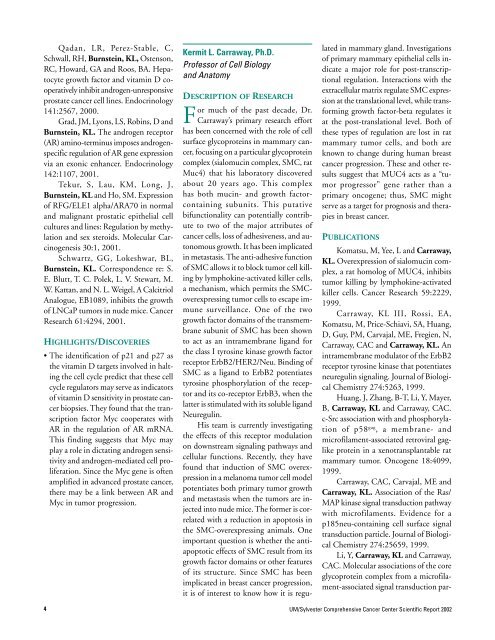tumor cell biology program - Sylvester Comprehensive Cancer Center
tumor cell biology program - Sylvester Comprehensive Cancer Center
tumor cell biology program - Sylvester Comprehensive Cancer Center
You also want an ePaper? Increase the reach of your titles
YUMPU automatically turns print PDFs into web optimized ePapers that Google loves.
Qadan, LR, Perez-Stable, C,<br />
Schwall, RH, Burnstein, KL, Ostenson,<br />
RC, Howard, GA and Roos, BA. Hepatocyte<br />
growth factor and vitamin D cooperatively<br />
inhibit androgen-unresponsive<br />
prostate cancer <strong>cell</strong> lines. Endocrinology<br />
141:2567, 2000.<br />
Grad, JM, Lyons, LS, Robins, D and<br />
Burnstein, KL. The androgen receptor<br />
(AR) amino-terminus imposes androgenspecific<br />
regulation of AR gene expression<br />
via an exonic enhancer. Endocrinology<br />
142:1107, 2001.<br />
Tekur, S, Lau, KM, Long, J,<br />
Burnstein, KL and Ho, SM. Expression<br />
of RFG/ELE1 alpha/ARA70 in normal<br />
and malignant prostatic epithelial <strong>cell</strong><br />
cultures and lines: Regulation by methylation<br />
and sex steroids. Molecular Carcinogenesis<br />
30:1, 2001.<br />
Schwartz, GG, Lokeshwar, BL,<br />
Burnstein, KL. Correspondence re: S.<br />
E. Blutt, T. C. Polek, L. V. Stewart, M.<br />
W. Kattan, and N. L. Weigel, A Calcitriol<br />
Analogue, EB1089, inhibits the growth<br />
of LNCaP <strong>tumor</strong>s in nude mice. <strong>Cancer</strong><br />
Research 61:4294, 2001.<br />
HIGHLIGHTS/DISCOVERIES<br />
• The identification of p21 and p27 as<br />
the vitamin D targets involved in halting<br />
the <strong>cell</strong> cycle predict that these <strong>cell</strong><br />
cycle regulators may serve as indicators<br />
of vitamin D sensitivity in prostate cancer<br />
biopsies. They found that the transcription<br />
factor Myc cooperates with<br />
AR in the regulation of AR mRNA.<br />
This finding suggests that Myc may<br />
play a role in dictating androgen sensitivity<br />
and androgen-mediated <strong>cell</strong> proliferation.<br />
Since the Myc gene is often<br />
amplified in advanced prostate cancer,<br />
there may be a link between AR and<br />
Myc in <strong>tumor</strong> progression.<br />
Kermit L. Carraway, Ph.D.<br />
Professor of Cell Biology<br />
and Anatomy<br />
DESCRIPTION OF RESEARCH<br />
For much of the past decade, Dr.<br />
Carraway’s primary research effort<br />
has been concerned with the role of <strong>cell</strong><br />
surface glycoproteins in mammary cancer,<br />
focusing on a particular glycoprotein<br />
complex (sialomucin complex, SMC, rat<br />
Muc4) that his laboratory discovered<br />
about 20 years ago. This complex<br />
has both mucin- and growth factorcontaining<br />
subunits. This putative<br />
bifunctionality can potentially contribute<br />
to two of the major attributes of<br />
cancer <strong>cell</strong>s, loss of adhesiveness, and autonomous<br />
growth. It has been implicated<br />
in metastasis. The anti-adhesive function<br />
of SMC allows it to block <strong>tumor</strong> <strong>cell</strong> killing<br />
by lymphokine-activated killer <strong>cell</strong>s,<br />
a mechanism, which permits the SMCoverexpressing<br />
<strong>tumor</strong> <strong>cell</strong>s to escape immune<br />
surveillance. One of the two<br />
growth factor domains of the transmembrane<br />
subunit of SMC has been shown<br />
to act as an intramembrane ligand for<br />
the class I tyrosine kinase growth factor<br />
receptor ErbB2/HER2/Neu. Binding of<br />
SMC as a ligand to ErbB2 potentiates<br />
tyrosine phosphorylation of the receptor<br />
and its co-receptor ErbB3, when the<br />
latter is stimulated with its soluble ligand<br />
Neuregulin.<br />
His team is currently investigating<br />
the effects of this receptor modulation<br />
on downstream signaling pathways and<br />
<strong>cell</strong>ular functions. Recently, they have<br />
found that induction of SMC overexpression<br />
in a melanoma <strong>tumor</strong> <strong>cell</strong> model<br />
potentiates both primary <strong>tumor</strong> growth<br />
and metastasis when the <strong>tumor</strong>s are injected<br />
into nude mice. The former is correlated<br />
with a reduction in apoptosis in<br />
the SMC-overexpressing animals. One<br />
important question is whether the antiapoptotic<br />
effects of SMC result from its<br />
growth factor domains or other features<br />
of its structure. Since SMC has been<br />
implicated in breast cancer progression,<br />
it is of interest to know how it is regulated<br />
in mammary gland. Investigations<br />
of primary mammary epithelial <strong>cell</strong>s indicate<br />
a major role for post-transcriptional<br />
regulation. Interactions with the<br />
extra<strong>cell</strong>ular matrix regulate SMC expression<br />
at the translational level, while transforming<br />
growth factor-beta regulates it<br />
at the post-translational level. Both of<br />
these types of regulation are lost in rat<br />
mammary <strong>tumor</strong> <strong>cell</strong>s, and both are<br />
known to change during human breast<br />
cancer progression. These and other results<br />
suggest that MUC4 acts as a “<strong>tumor</strong><br />
progressor” gene rather than a<br />
primary oncogene; thus, SMC might<br />
serve as a target for prognosis and therapies<br />
in breast cancer.<br />
PUBLICATIONS<br />
Komatsu, M, Yee, L and Carraway,<br />
KL. Overexpression of sialomucin complex,<br />
a rat homolog of MUC4, inhibits<br />
<strong>tumor</strong> killing by lymphokine-activated<br />
killer <strong>cell</strong>s. <strong>Cancer</strong> Research 59:2229,<br />
1999.<br />
Carraway, KL III, Rossi, EA,<br />
Komatsu, M, Price-Schiavi, SA, Huang,<br />
D, Guy, PM, Carvajal, ME, Fregien, N,<br />
Carraway, CAC and Carraway, KL. An<br />
intramembrane modulator of the ErbB2<br />
receptor tyrosine kinase that potentiates<br />
neuregulin signaling. Journal of Biological<br />
Chemistry 274:5263, 1999.<br />
Huang, J, Zhang, B-T, Li, Y, Mayer,<br />
B, Carraway, KL and Carraway, CAC.<br />
c-Src association with and phosphorylation<br />
of p58 gag , a membrane- and<br />
microfilament-associated retroviral gaglike<br />
protein in a xenotransplantable rat<br />
mammary <strong>tumor</strong>. Oncogene 18:4099,<br />
1999.<br />
Carraway, CAC, Carvajal, ME and<br />
Carraway, KL. Association of the Ras/<br />
MAP kinase signal transduction pathway<br />
with microfilaments. Evidence for a<br />
p185neu-containing <strong>cell</strong> surface signal<br />
transduction particle. Journal of Biological<br />
Chemistry 274:25659, 1999.<br />
Li, Y, Carraway, KL and Carraway,<br />
CAC. Molecular associations of the core<br />
glycoprotein complex from a microfilament-associated<br />
signal transduction par-<br />
4<br />
UM/<strong>Sylvester</strong> <strong>Comprehensive</strong> <strong>Cancer</strong> <strong>Center</strong> Scientific Report 2002
















